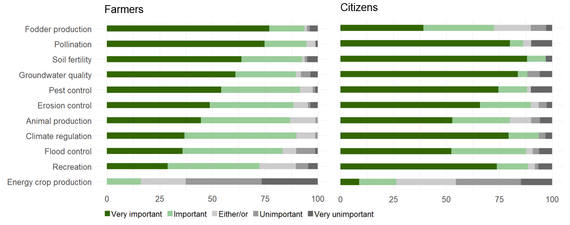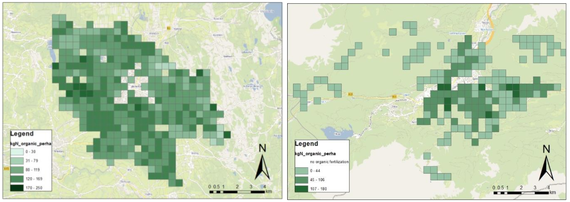During phase I of the project, we interviewed farmers and citizens in the SUSALPS study region in order to evaluate their perception of grassland-related ecosystem services and the acceptance of different grassland management options. As depicted in Figure 1, the results reveal consensus of the two stakeholder groups concerning the values of some ecosystem services, but also strong differences. For example, farmers valued fodder production much higher than citizens who considered recreation as most important. However, both stakeholder groups agree that pollination is highly valuable. Furthermore, the survey results show that, with respect to management decisions, weather and legal constraints have the highest impact on fertilization decisions.
As economic considerations play an important role in management decisions affecting ecosystem services, field-specific gross-margins were assessed with the calculator of the Bavarian Institute of Agriculture (LfL) (https://www.stmelf.bayern.de/idb/default.html). The results indicate a strong heterogeneity in the cost-benefit ratio of the grasslands due to differences in management practices, soil parameters, and agro-environmental payment schemes.
This important information will be used for the further development of a bio-economic model in project phase II. Modelling work in phase I concentrated on the conceptual development of the model, i.e. coupling of the LandscapeDNDC with a socio-economic model. The latter was implemented as an agent-based model (ABM) in NetLogo that describes the effects of different policies on farmer’s decisions for grassland management with a particular focus on spatially-explicit fertilizer outputs.
First outcomes show patterns of high fertilization in sub-alpine regions around Weilheim (Figure 2, left) and very extensive fertilization regimes in the alpine environment near Garmisch-Partenkirchen (Figure 2, right) surrounded by steep slopes. The results of this socio-economic ABM are useful to assess potential impacts of policies on grassland management and can serve as a supporting tool for the identification of suitable policy measures, but also for farmers’ decision making. Furthermore, the ABM can be used for the interaction with farmers, policy makers and experts since it provides quantitative data on Nitrogen output coupled with real-world maps in a graphical user interface.


